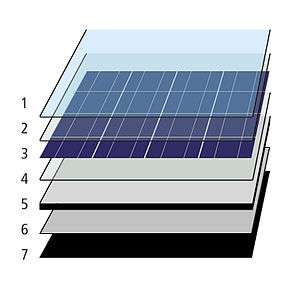Photovoltaic thermal hybrid solar collector

1 - Anti-reflective glass
2 - EVA-encapsulant
3 - Solar PV cells
4 - EVA-encapsulant
5 - Backsheet (PVF)
6 - Heat exchanger (copper)
7 - Insulation (polyurethane)
Photovoltaic thermal hybrid solar collectors, sometimes known as hybrid PV/T systems or PVT, are systems that convert solar radiation into thermal and electrical energy. These systems combine a solar cell, which converts sunlight into electricity, with a solar thermal collector, which captures the remaining energy and removes waste heat from the PV module. and thus be more overall energy efficient than solar photovoltaic (PV) or solar thermal alone.[1] A significant amount of research has gone into developing PVT technology since the 1970s.[2]
Photovoltaic cells suffer from a drop in efficiency with the rise in temperature due to increased resistance. Such systems can be engineered to carry heat away from the PV cells thereby cooling the cells and thus improving their efficiency by lowering resistance.[3] Although this is an effective method, it causes the thermal component to under-perform compared to a solar thermal collector.
System types
A number of PV/T collectors in different categories are commercially available and can be divided into the following categories:
- PV/T liquid collector
- PV/T air collector
- PV/Ta Liquid and air collector
- PV/T concentrator (CPVT)
PV/T liquid collector
The basic water-cooled design uses a channel to direct fluid flow using piping of various materials or plates attached to the back of a PV module. The fluid flow arrangement through the cooling element will determine which systems the panels are most suited to.
In a standard fluid-based system, a working fluid, typically water, glycol or mineral oil is then piped through these pipes or plate chillers. The heat from the PV cells is conducted through the metal and absorbed by the working fluid (presuming that the working fluid is cooler than the operating temperature of the cells). In closed-loop systems this heat is either exhausted (to cool it), or transferred at a heat exchanger, where it flows to its application. In open-loop systems, this heat is used, or exhausted before the fluid returns to the PV cells.[4] It is also possible to disperse nanoparticles in the liquid to create a liquid filter for PV/T applications.[5][6][7] The basic advantage of this type of split configuration is that the thermal collector and the photovoltaic collector can operate at different temperatures.
PV/T air collector
The basic air-cooled design uses a hollow, conductive metal housing to mount the photo-voltaic (PV) panels. Heat is radiated from the panels into the enclosed space, where the air is either circulated into a building HVAC system to recapture heat energy, or rises and is vented from the top of the structure.
While energy transfer to air is not as efficient as a liquid collector, the infrastructure required has lower cost and complexity; basically a shallow metal box. Placement of PV panels can be vertical or angled.[8]
PV/T concentrator (CPVT)
A concentrator system has the advantage to reduce the amount of photovoltaic (PV) cells needed, such that somewhat more expensive and efficient multi-junction photovoltaic cells can be used that will maximize the ratio of produced high-value electrical power versus lower-value thermal power. A major limitation of high-concentrator (i.e. HCPV and HCPVT) systems is that they maintain their advantage over conventional c-Si/mc-Si collectors only in regions that remain consistently free of atmospheric aerosol contaminants (e.g. light clouds, smog, etc.). Concentrator system performance is especially degraded because 1) radiation is reflected and scattered outside of the small (often less than 1°-2°) acceptance angle of the collection optics, and 2) absorption of specific components of the solar spectrum causes one or more series junctions within the MJ cells to underperform.[9]
Concentrator systems also require reliable control systems to accurately track the sun and to protect the PV cells from damaging over-temperature conditions. Under ideal conditions, about 75% of the suns power directly incident upon such systems can be gathered as electricity and heat. For more details, see the discussion of CPVT within the article for concentrated photovoltaics.
See also
References
- ↑ Ahmad Mojiri, Robert A. Taylor, Elizabeth Thomsen, Gary Rosengarten, Spectral beam splitting for efficient conversion of solar energy — A review. In: Renewable and Sustainable Energy Reviews 28, December 2013, Pages 654–663, doi:10.1016/j.rser.2013.08.026
- ↑ Chow, T. T. (2010). "A review on photovoltaic/thermal hybrid solar technology". Applied Energy. 87 (2): 365–379. doi:10.1016/j.apenergy.2009.06.037.
- ↑ S.A. Kalogirou, Y. Tripanagnostopoulos (30 January 2006). These systems are most often used for domestic hot water (DHW) and electricity production
- ↑ Y. Tripanagnostopoulos, M. Souliotis, R. Battisti, A. Corrado "APPLICATION ASPECTS OF HYBRID PV/T SOLAR SYSTEMS" http://www.ecn.nl/fileadmin/ecn/units/egon/pvt/pdf/ises03_lca.pdf
- ↑ Taylor, R.A.; Otanicar, T.; Rosengarten, G. (2012). "Nanofluid-based optical filter optimization for PV/T systems". Light: Science & Applications. 1: e34. Bibcode:2012LSA.....1E..34T. doi:10.1038/lsa.2012.34.
- ↑ Taylor, R.A.; Otanicar, T; Herukerrupu, Y; Bremond, F; Rosengarten, G; Hawkes, E; Jiang, X.; Coulombe, S (2013). "Feasibility of nanofluid-based optical filters". Applied Optics. 52 (7): 1413–1422. Bibcode:2013ApOpt..52.1413T. doi:10.1364/AO.52.001413. PMID 23458793.
- ↑ Otanicar, T.P.; Taylor, R. A.; Telang, C. (2013). "Photovoltaic/thermal system performance utilizing thin film and nanoparticle dispersion based optical filters". Journal of Renewable and Sustainable Energy. 5: 033124. doi:10.1063/1.4811095.
- ↑ "PV Thermal". Solarwall. Retrieved 15 February 2017.
- ↑ "Analysis of the spectral variations on the performance of high concentrator photovoltaic modules operating under different real climate conditions, E.F. Fernandez et.al., Solar Energy Materials & Solar Cells, 2014" (PDF).
